In photography, bracketing is the general technique of taking several shots of the same subject using different camera settings, typically with the aim of combining the images in postprocessing. Bracketing is useful and often recommended in situations that make it difficult to obtain a satisfactory image with a single shot, especially when a small variation in exposure parameters has a comparatively large effect on the resulting image. Given the time it takes to accomplish multiple shots, it is typically, but not always, used for static subjects. Autobracketing is a feature of many modern cameras. When set, it will automatically take several bracketed shots, rather than the photographer altering the settings by hand between each shot.

Minolta Co., Ltd. was a Japanese manufacturer of cameras, camera accessories, photocopiers, fax machines, and laser printers. Minolta Co., Ltd., which is also known simply as Minolta, was founded in Osaka, Japan, in 1928 as Nichi-Doku Shashinki Shōten. It made the first integrated autofocus 35 mm SLR camera system. In 1931, the company adopted its final name, an acronym for "Mechanism, Instruments, Optics, and Lenses by Tashima".

The Nikon FA is an advanced amateur-level, interchangeable lens, 35 mm film, single-lens reflex (SLR) camera. It was manufactured by the Japanese optics company Nippon Kogaku K. K. in Japan from 1983 to 1987. The FA used a titanium-bladed, vertical-travel Nikon-designed, Copal-made focal plane shutter with a speed range of 1 to 1/4000th second plus Bulb and flash X-sync of 1/250th second. It was available in two colors: black with chrome trim and all black. The introductory US list price for the chrome body only was $646. Note that SLRs usually sold for 30 to 40 percent below list price.

The Canon A-1 is an advanced-level single-lens reflex (SLR) 35 mm film camera for use with interchangeable lenses. It was manufactured by Canon Camera K. K. in Japan from March 1978 to 1985. It employs a horizontal cloth-curtain focal-plane shutter with a speed range of 30 to 1/1000 second plus bulb and flash synchronization speed of 1/60 second. It has dimensions of 92 millimetres (3.6 in) height, 141 millimetres (5.6 in) width, 48 millimetres (1.9 in) depth and 620 grams (22 oz) weight. Unlike most SLRs of the time, it was available in only one color; all black. The introductory US list price for the body plus Canon FD 50 mm f/1.4 SSC lens was $625; the camera body was generally sold with a 30–40% discount.

The Nikon FG is an interchangeable lens, 35 mm film, single-lens reflex (SLR) camera. It was manufactured by Nippon Kogaku K. K. in Japan from 1982 to 1986.

The EOS IX or EOS IX E is an APS-format single-lens reflex camera that was introduced by Canon Inc. of Japan in October 1996 as part of their EOS series SLR cameras. The other APS camera in this series is the Canon EOS IX Lite, also known as the EOS IX 7. Production ended in 2001.

The Minolta XG-M was a 35mm single-lens reflex camera introduced in 1981 by Minolta of Japan. It was also known as the X-70 on the Japanese market, in which it was not available until 1982. When released, it was the top model in Minolta's XG series of consumer-grade manual focus SLRs, replacing the XG-9. Changes from that model included a metered manual mode, and a revised body style with rearranged controls. This was also the first camera to use Minolta's new logo, which was used until the 2003 merger into Konica Minolta.
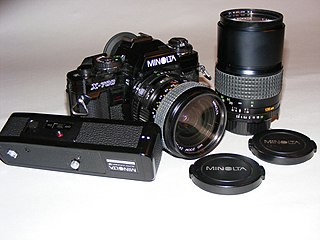
The Minolta X-700 is a 35 mm single-lens reflex film camera introduced by Minolta in 1981. It was the top model of their final manual-focus SLR series before the introduction of the auto-focus Minolta Maxxum 7000.

The Minolta 110 Zoom SLR is a 110 format single-lens reflex (SLR) camera produced by Minolta of Japan between 1976 and 1979. It was the first SLR in 110 format. It has an unusual, flattened shape. Other 110 SLRs were shaped like SLRs in larger formats, but the 110 Zoom SLR took the flat format of the typical 110 pocket camera and added a larger lens and prism hump to it. 1979's replacement, the Minolta 110 Zoom SLR Mark II, has a more conventional shape.
Autobracketing is a feature of some more advanced cameras, whether film or digital cameras, particularly single-lens reflex cameras, where the camera will take several successive shots with slightly different settings. The images may be automatically combined, for example into one high-dynamic-range image, or they may be stored separately so the best-looking pictures can be picked later from the batch. When the photographer achieves the same result by changing the camera settings between each shot, this is simply called bracketing.
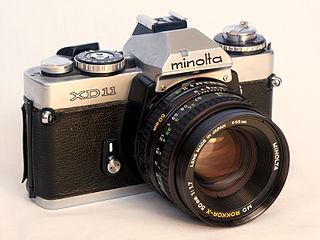
The Minolta XD-7 is a 35mm SLR film camera manufactured by Minolta from 1977 until 1984.
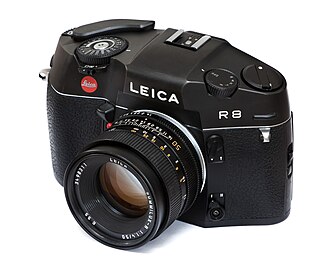
The Leica R8 & R9 are manual focus 35 mm single-lens reflex cameras produced by the German firm Leica as the final models of their R series. Development of the R8 began in 1990: the camera was introduced at the 1996 photokina trade show, and was succeeded by the similar Leica R9 in 2002.

The Maxxum 7D, labelled Dynax 7D in Europe/Hong Kong and α-7 Digital in Japan and officially named "DG-7D", is a 6.1 megapixel digital single-lens reflex camera, or DSLR, produced by Konica Minolta. It was the top model of their DSLR range; the Maxxum/Dynax 5D consumer-grade model was the other.

The Minolta A-mount camera system was a line of photographic equipment from Minolta introduced in 1985 with the world's first integrated autofocus system in the camera body with interchangeable lenses. The system used a lens mount called A-mount, with a flange focal distance 44.50 mm, one millimeter longer, 43.5 mm, than the previous SR mount from 1958. The new mount was wider, 49.7 mm vs. 44.97 mm, than the older SR-mount and due to the longer flange focal distance, old manual lenses were incompatible with the new system. Minolta bought the autofocus technology of Leica Correfot camera which was partly used on the a-mount autofocus technology. The mount is now used by Sony, who bought the SLR camera division from Konica Minolta, Konica and Minolta having merged a few years before.

The Konica Hexar RF is a 35 mm rangefinder camera which was sold by Konica. It was introduced to the market on 13 October 1999. and subsequently discontinued some time before the end of 2003. The camera used the "Bayonet Konica KM-mount", a copy of the Leica M-mount, thus sharing interchangeable lenses with those designed for Leica cameras and others compatible with them. The Hexar RF has a combined rangefinder/viewfinder modeled on that of Leica cameras, a similar body shape and size - and so is similar to Leica M-mount cameras in many aspects of operation.

The Konica Hexar is a 35 mm fixed-lens, fixed focal length autofocus camera which was produced through the 1990s. It was introduced to the market in 1993. While styled like a rangefinder camera, and intended for a similar style of photography, in specification it is more like a larger "point and shoot" camera.
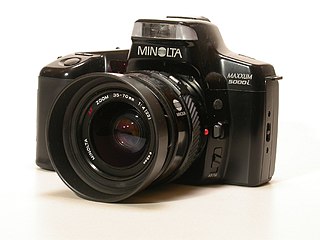
The Minolta 5000i is a 35mm single-lens reflex camera belonging to the second generation of bodies in Minolta's autofocus SLR system, fitting between the cheaper 3000i and the more expensive, semi-pro 7000i, and replacing the 5000. The "i" in the names of the new camera range stood for "intelligence". Like the 7000i, the 5000i supported Minolta's Creative Expansion Cards, plug-in electronic modules that added new functionality to the camera.

The Minolta 9xi was, when released in 1992, an advanced 35 mm single-lens reflex camera design. According to the company, it incorporated the world's "fastest autofocus system", had a maximum shutter speed of 1/12000 of a second, and had a 14-zone metering system. It has a shooting speed of 4.5 frames per second without the additional motor pack, a shutter speed of 1/12000 of a second due to carbon-reinforced shutter blades, a pentaprism, and it is compatible with xi zoom lenses having a "power zoom function".
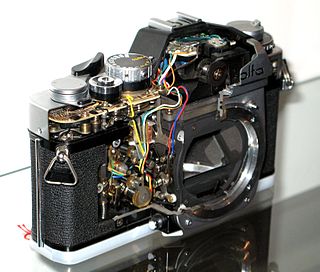
The Minolta SR-mount was the bayonet mounting system used in all 35 mm SLR cameras made by Minolta with interchangeable manual focusing lenses. Several iterations of the mounting were produced over the decades, and as a result, the mount itself was sometimes referred to by the name of the corresponding lens generation instead.

The Minolta X-1 was the professional model in the Minolta SR-mount line of single-lens reflex cameras (SLR), released in 1972 after ten years of development, which was the first X-series camera in the Minolta SLR system; prior to the X-1, specific Minolta SLR models were branded SR-T, and afterward, they included X in the name. The X-1 was the first SLR to combine an electronically-controlled shutter with interchangeable viewfinders.




















